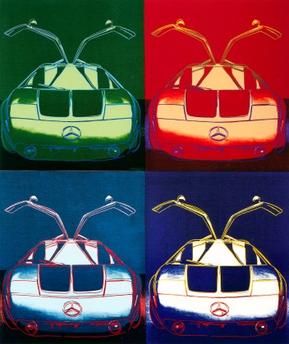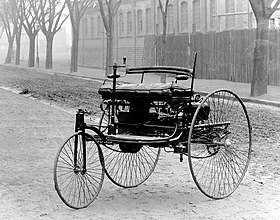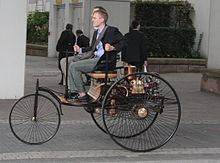
CarlFriedrich Benz was a German engine designer and automotive engineer. His Benz Patent Motorcar from 1885 is considered the first practical modern automobile and first car put into series production. He received a patent for the motorcar in 1886, the same year he first publicly drove the Benz Patent-Motorwagen.

Driving is the controlled operation and movement of a land vehicle, including cars, motorcycles, trucks, and buses. Permission to drive on public highways is granted based on a set of conditions being met and drivers are required to follow the established road and traffic laws in the location they are driving. The word driving, has etymology dating back to the 15th century and has developed as what driving has encompassed has changed from working animals in the 15th to automobiles in the 1800s. Driving skills have also developed since the 15th century with physical, mental and safety skills being required to drive. This evolution of the skills required to drive have been accompanied by the introduction of driving laws which relate to not only the driver but the driveability of a car.

Wilhelm Maybach was an early German engine designer and industrialist. During the 1890s he was hailed in France, then the world centre for car production, as the "King of Designers".

Mannheim, officially the University City of Mannheim, is the second-largest city in the German state of Baden-Württemberg, after the state capital of Stuttgart, and Germany's 21st-largest city, with a 2021 population of 311,831 inhabitants. The city is the cultural and economic centre of the Rhine-Neckar Metropolitan Region, Germany's seventh-largest metropolitan region with nearly 2.4 million inhabitants and over 900,000 employees.

Gottlieb Wilhelm Daimler was a German engineer, industrial designer and industrialist born in Schorndorf, in what is now Germany. He was a pioneer of internal-combustion engines and automobile development. He invented the high-speed liquid petroleum-fueled engine.

An antique car is an automobile that is an antique. Narrower definitions vary based on how old a car must be to qualify. The Antique Automobile Club of America defines an antique car as over 25 years of age. However, the legal definitions for the purpose of antique vehicle registration vary widely. The antique car era includes the Veteran era, the Brass era, and the Vintage era, which range from the beginning of the automobile up to the 1930s. Later cars are often described as classic cars. In original or originally restored condition antiques are very valuable and are usually either protected and stored or exhibited in car shows but are very rarely driven.

Horseless carriage is an early name for the motor car or automobile. Prior to the invention of the motor car, carriages were usually pulled by animals, typically horses. The term can be compared to other transitional terms, such as wireless phone. These are cases in which a new technology is compared to an older one by describing what the new one does not have.

Bertha Benz was a German automotive pioneer. She was the business partner, investor and wife of automobile inventor Karl Benz. On 5 August 1888, she was the first person to drive an internal-combustion-engined automobile over a long distance, field testing the Benz Patent-Motorwagen, inventing brake lining and solving several practical issues during the journey of 105 km. In doing so, she brought the Patent-Motorwagen worldwide attention and got their company its first sales. Bertha Benz was not allowed to study in the Grand Duchy of Baden and her financial and practical engineering contributions have long been overlooked until the 21 st century.

The Benz Velo was one of the first cars, introduced by Carl Benz in 1894 as the followup to the Patent Motorwagen. 67 Benz Velos were built in 1894 and 134 in 1895. The early Velo had a 1L 1.5-metric-horsepower engine, and later a 3-metric-horsepower engine giving a top speed of 19 km/h (12 mph). The Velo was officially introduced by Karl Benz as the Velocipede, and became the world's first standardized serial production car. The Velocipede remained in production between 1894 and 1902, with a final count of over 1,200 produced.

Wiesloch is a town in northern Baden-Württemberg, Germany. It is situated 13 kilometres south of Heidelberg. After Weinheim, Sinsheim and Leimen, it is the fourth largest town in the Rhein-Neckar-Kreis. It shares Wiesloch-Walldorf station with its neighbouring town Walldorf. Also in the vicinity of Wiesloch are Dielheim, Malsch, Mühlhausen, Rauenberg and Sankt Leon-Rot.

Development of the automobile started in 1672 with the invention of the first steam-powered vehicle, which led to the creation of the first steam-powered automobile capable of human transportation, built by Nicolas-Joseph Cugnot in 1769. Inventors began to branch out at the start of the 19th century, creating the de Rivaz engine, one of the first internal combustion engines, and an early electric motor. Samuel Brown later tested the first industrially applied internal combustion engine in 1826. Only two of these were made.

Daimler-Motoren-Gesellschaft was a German engineering company and later automobile manufacturer, in operation from 1890 until 1926. Founded by Gottlieb Daimler (1834–1900) and Wilhelm Maybach (1846–1929), it was based first in Cannstatt. Daimler died in 1900, and their business moved in 1903 to Stuttgart-Untertürkheim after the original factory was destroyed by fire, and again to Berlin in 1922. Other factories were located in Marienfelde and Sindelfingen.

A road trip, sometimes spelled roadtrip, is a long-distance journey traveled by automobile.

The Daimler Motorized Carriage was the first car produced by German engineers Gottlieb Daimler and Wilhelm Maybach, who founded Daimler Motoren Gesellschaft (DMG). The first car was sold in 1892.

A car, or an automobile, is a motor vehicle with wheels. Most definitions of cars state that they run primarily on roads, seat one to eight people, have four wheels, and mainly transport people, not cargo.
Mercedes-Benz, commonly referred to as Mercedes and sometimes as Benz, is a German luxury and commercial vehicle automotive brand established in 1926. Mercedes-Benz AG is headquartered in Stuttgart, Baden-Württemberg, Germany. Mercedes-Benz AG produces consumer luxury vehicles and light commercial vehicles badged as Mercedes-Benz. From November 2019 onwards, Mercedes-Benz-badged heavy commercial vehicles are managed by Daimler Truck, a former part of the Mercedes-Benz Group turned into an independent company in late 2021. In 2018, Mercedes-Benz was the largest brand of premium vehicles in the world, having sold 2.31 million passenger cars.

The Mercedes-Benz F-Cell Roadster is a concept car produced by the German car company Mercedes-Benz. During April 2009, the concept car has traveled the Bertha Benz Memorial Route thus celebrating the exploits of Mrs. Bertha Benz in 1888.

The Bertha Benz Memorial Route is a German tourist and theme route in Baden-Württemberg and member of the European Route of Industrial Heritage. It opened in 2008 and follows the tracks of the world's first long distance road trip by a vehicle powered with an internal combustion engine, in 1888.

Cars is a series of artworks by the American artist Andy Warhol, commissioned by Mercedes-Benz in 1986.





















